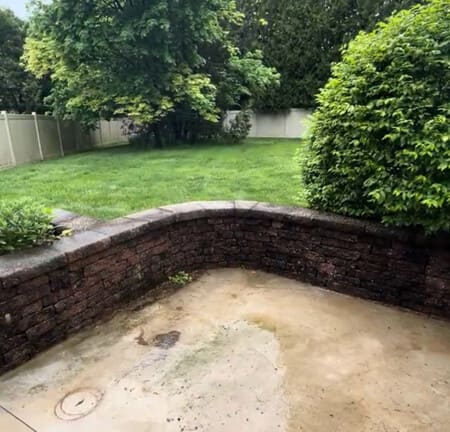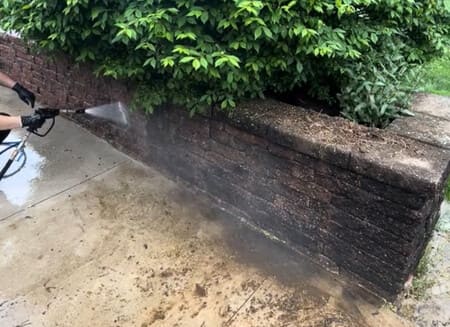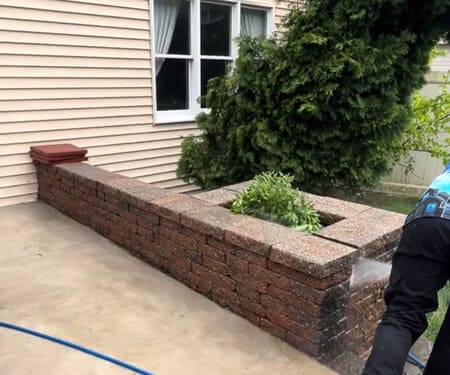Retaining Wall Cleaning In 2025: How to/Complete Guide

In this guide, we’ll provide you with the best methods for cleaning your retaining wall in 2025, covering various materials, eco-friendly cleaning solutions, and useful tips to keep your retaining wall in top shape.
Why Regular Retaining Wall Cleaning Matters
Cleaning your retaining wall regularly offers multiple benefits:
- ✔ Enhance curb appeal by removing dirt, algae, and moss
- ✔ Prevent the buildup of mold and mildew that can weaken the wall’s structure
- ✔ Increase longevity by preventing staining and surface degradation
- ✔ Improve safety by removing slippery algae that can cause accidents
Whether your retaining wall is made from brick, stone, concrete, or timber, keeping it clean ensures it stays functional and visually appealing.
Best Retaining Wall Cleaning Methods for 2025
The best cleaning method depends on the type of material your retaining wall is made of. Here are the most effective ways to clean various retaining wall surfaces:
Pressure Washing (For Brick, Stone, and Concrete Walls)
Pressure washing is the most efficient way to clean tough surfaces like concrete, brick, or stone retaining walls. It helps remove dirt, algae, moss, and other stubborn stains.
Best Cleaning Method:
- Remove Debris – Sweep away loose dirt, leaves, and other debris from the wall.
- Pre-Treat Stains – Apply a suitable cleaner for algae, mold, or oil stains.
- Use a Pressure Washer (2000-3000 PSI) – Use a medium pressure setting to avoid damaging the surface.
- Work in Sections – Clean the wall in small sections to ensure thorough cleaning.
- Rinse Thoroughly – After cleaning, rinse the surface to remove any detergent or cleaner residue.
✔ Pro Tip: Keep the nozzle about 12-18 inches from the wall to avoid damaging the surface, especially for softer materials.
Soft Washing (For Wooden and Fragile Walls)

Soft washing is a low-pressure cleaning technique that’s ideal for wooden, treated timber, or delicate retaining walls. It helps remove dirt and mold without damaging the surface or finish.
Best Cleaning Method:
- Apply a Biodegradable Cleaner – Use a natural cleaning solution that’s safe for wood and stone.
- Let the Cleaner Sit – Allow the solution to work for 10-15 minutes to break down dirt and algae.
- Gently Rinse with Low Pressure – Use a low-pressure nozzle to wash the surface without causing splintering or surface damage.
- Scrub Stubborn Areas – Use a soft brush to scrub areas with heavy mold or dirt buildup.
- Rinse Well – Rinse off any leftover solution to prevent staining.
✔ Pro Tip: Soft washing is especially important for wooden retaining walls to prevent damage and preserve their integrity.
Eco-Friendly Retaining Wall Cleaning Solutions
For those who prefer environmentally friendly cleaning methods, there are several natural cleaning solutions you can use:
- ✅ Vinegar and Water Solution – A mixture of vinegar and water can effectively break down algae and mold without chemicals.
- ✅ Baking Soda and Water – Great for removing dirt and grime while being gentle on your wall’s surface.
- ✅ Hydrogen Peroxide – A powerful natural disinfectant that can help clean mold and mildew from your retaining wall.
- ✅ Dish Soap and Warm Water – Ideal for regular cleaning and removing minor dirt and grime.
✔ Pro Tip: Always test your eco-friendly solutions on a small, inconspicuous area to ensure they won’t cause discoloration or damage.
How Often Should You Clean Your Retaining Wall?

The frequency of cleaning depends on the material and the level of exposure to the elements:
- Concrete, Brick, and Stone Walls: Clean every 6-12 months to remove dirt, algae, and moss.
- Wooden Retaining Walls: Clean every 6-9 months to prevent mold, mildew, and discoloration.
- High Moisture Areas (shaded or near water): Clean more frequently, as moss, algae, and mold grow faster in humid conditions.
✔ Pro Tip: After heavy rains or storms, check for debris or visible algae growth and clean as needed to prevent long-term damage.
Final Tips
- ✅ Pressure wash for concrete, brick, or stone retaining walls to remove deep stains and dirt.
- ✅ Use soft washing for wooden or fragile retaining walls to prevent damage and preserve the surface.
- ✅ Clean every 6-12 months, or more frequently in areas prone to moss, algae, or mold buildup.
- ✅ Test eco-friendly cleaners on small areas before using them on the entire wall.
If you need professional help with cleaning your retaining wall, consider reaching out to a trusted cleaning service for a thorough and safe cleaning solution.
With regular cleaning, your retaining wall will remain an attractive and durable feature of your landscape. Get started today and enjoy a well-maintained, visually appealing outdoor space in 2025!
Ready to make cleaning less of a chore? Pick the one that suits your needs and let the pressure washing magic begin at A&M Spotless today. For any pressure washing grime, give us a call at (484-255-4478).
GET YOUR FREE WINDOW CLEANING OR PRESSURE WASHING QUOTE IN BETHLEHEM, PA TODAY!!!
Additional Resources
If you want to dig deeper into cleaning techniques or need recommendations for products, check out more of our guides on pressure washing, or even consider calling us A&M Spotless (484-255-4478) for the big jobs. You will thank us!